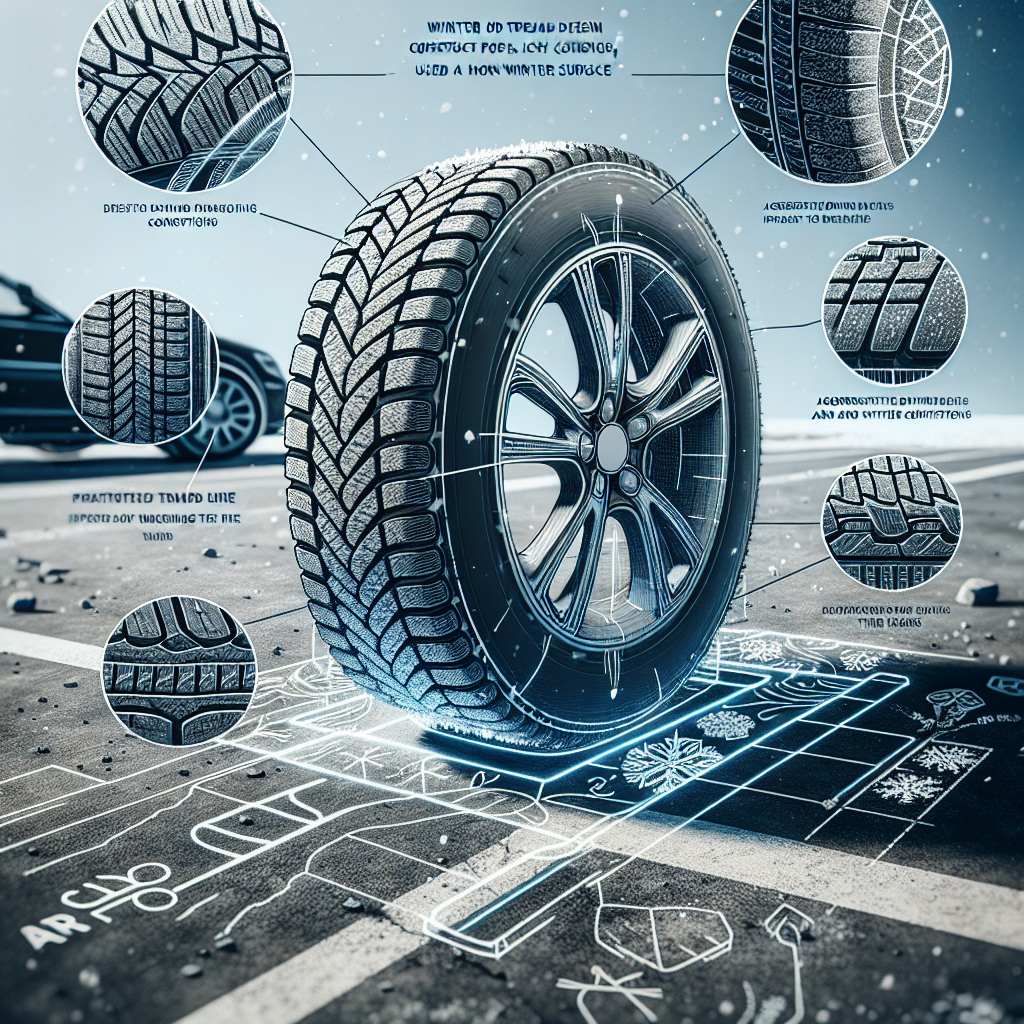Picture this: it’s a beautiful winter morning, the roads are dry, and you’re happily cruising along in your car. But suddenly, a question pops up in your mind: can winter tires wear out quickly on dry pavement? It’s a valid concern, as winter tires are specifically designed to excel in snowy and icy conditions, but what happens when they encounter dry roads? In this article, we’ll explore this intriguing topic and uncover whether or not your winter tires may be at risk of wearing out prematurely on dry pavement. So, fasten your seatbelt and let’s hit the road of discovery together!
Effect of Winter Tires on Dry Pavement
Introduction to winter tires
Winter tires, also known as snow tires, are specially designed tires that provide superior traction and handling performance in winter conditions. They are made with a unique tread pattern and rubber compound that ensures optimal grip on icy and snowy surfaces. While winter tires are primarily designed for use in cold and snowy conditions, many drivers wonder how these specialized tires perform on dry pavement.
Understanding dry pavement
Dry pavement refers to road surfaces that are free of moisture, such as rain, snow, or ice. It is the most common driving condition for most parts of the year, especially in regions with a temperate climate. Dry pavement offers excellent traction and allows for quick braking and precise handling, making it easier to maneuver a vehicle.
The purpose of winter tires
The main purpose of winter tires is to enhance safety and performance in cold weather conditions. They are specifically designed to provide increased traction on snow and ice, reducing the risk of accidents and improving overall control. Winter tires use unique tread designs that have wider grooves and smaller tread blocks, allowing them to bite into snow and ice and maintain grip on slippery surfaces.
Characteristics of winter tires
Winter tires have several distinct characteristics that contribute to their superior performance in winter conditions. They are made from a softer rubber compound, which maintains flexibility and grip even in cold temperatures. The tread patterns of winter tires feature deep grooves and biting edges that provide excellent traction on snow and ice. These tires also have sipes or small slits in the tread blocks that help expel water, improving grip on wet surfaces.
Comparison with all-season tires
Winter tires are designed to perform optimally in cold weather and road conditions with snow and ice. All-season tires, on the other hand, are designed to provide adequate performance in a variety of weather conditions, including dry and wet pavement. While all-season tires can handle light snow and slush, they are not as effective as winter tires in providing traction on slippery surfaces. All-season tires have a harder rubber compound and less aggressive tread patterns than winter tires, making them less suitable for harsh winter conditions.
Factors Affecting Tire Wear
Road surface temperature
The temperature of the road surface has a significant impact on tire wear. In colder temperatures, the rubber compound of tires becomes stiffer, leading to increased wear. Winter tires are designed to maintain their flexibility and grip in cold weather, but when driven on dry pavement in warmer temperatures, they may wear out faster compared to all-season tires.
Driving style and habits
The way you drive can affect the wear of your tires. Aggressive driving, such as rapid acceleration, hard braking, and excessive cornering, can increase tire wear. Smooth and controlled driving, on the other hand, helps minimize wear and prolong the life of your tires. It is important to maintain a safe driving style and avoid sudden maneuvers, regardless of the type of tires you are using.
Frequency of use
The more you drive, the faster your tires will wear out. Winter tires, especially, may wear out quicker when driven extensively on dry pavement. If you live in an area with mild winters and rarely encounter snowy or icy conditions, it is advisable to switch to all-season tires during the non-winter months to extend the life of your winter tires.
Tire pressure and maintenance
Proper tire pressure is crucial for tire longevity and performance. Underinflated tires can cause excessive wear on the shoulders, while overinflated tires can lead to wear in the center of the tread. Regularly checking and maintaining the recommended tire pressure will help ensure even wear and prolong the life of your tires. Additionally, regular tire maintenance, such as tire rotations and alignments, can help prevent uneven wear patterns and extend tire life.
Tire composition and quality
The quality and composition of the tires themselves can impact their wear and durability. Higher-quality winter tires are typically designed with a tread compound that offers a better balance of grip and wear resistance. Cheaper or low-quality tires may wear out quicker on dry pavement due to their inferior construction and materials. Investing in high-quality, reputable winter tires can contribute to their longer lifespan.

Tire Tread and Wear Patterns
Tire tread depth
The depth of tire tread plays a significant role in determining the level of traction and performance. Winter tires generally have deeper tread patterns to aid in gripping snow and ice. However, on dry pavement, this deeper tread can result in increased tire wear. It is crucial to regularly check the tread depth of your tires and replace them when they reach the recommended minimum depth, as decreased tread depth can compromise traction and performance.
Tire rotation
Regular tire rotation is important for maintaining even wear and extending the life of your tires. Winter tires typically experience more wear on the drive wheels due to the increased torque applied during acceleration. Rotating the tires at regular intervals, typically every 5,000 to 7,000 miles, ensures that the wear is distributed evenly across all four tires, promoting longer tire life and optimal performance.
Alignment and suspension issues
Improper wheel alignment or suspension problems can cause uneven tire wear, affecting both the performance and longevity of your tires. Misaligned wheels can cause the tires to wear unevenly on the inner or outer edges, while suspension issues can lead to cupping or scalloping of the tread. Regular inspections and alignments by a professional can help identify and correct any alignment or suspension issues, preventing premature tire wear.
Over/under inflation
Incorrect tire pressure can lead to uneven wear and reduce tire life. Overinflated tires may wear out more in the center of the tread, while underinflated tires can wear more on the shoulders. It is essential to maintain the recommended tire pressure to ensure even wear and maximize the lifespan of your tires.
Uneven wear patterns
Various factors, such as misalignment, improper tire pressure, and driving conditions, can contribute to uneven wear patterns on tires. These patterns include feathering, cupping, or one-sided wear. Uneven wear not only compromises the performance and traction of the tires but may also indicate underlying issues with the vehicle’s alignment or suspension. Regular inspections and addressing any signs of uneven wear are crucial in maintaining tire longevity.
Performance of Winter Tires on Dry Pavement
Braking and handling capabilities
While winter tires are primarily designed for snowy and icy conditions, they can still provide good performance on dry pavement. Winter tires often have softer rubber compounds that offer enhanced grip and braking capabilities, which can improve overall handling and control in both wet and dry conditions. However, it is important to note that winter tires may not offer the same level of performance as all-season tires on dry pavement, especially in terms of handling and responsiveness.
Road noise and comfort
Winter tires are generally known for producing more road noise compared to all-season tires. The aggressive tread patterns and softer rubber compounds that enable winter tires to excel in winter conditions can contribute to increased noise levels on dry pavement. This can result in a less comfortable and quieter driving experience for some drivers.
Fuel efficiency
Winter tires may have a minor impact on fuel efficiency when driven on dry pavement. The softer rubber compounds and more aggressive tread patterns can increase rolling resistance, which may lead to slightly reduced fuel economy. However, the impact on fuel efficiency is typically minimal and may not be noticeable in day-to-day driving.
Durability and long-term performance
Winter tires’ durability and long-term performance on dry pavement can vary depending on various factors, including tire quality, driving habits, and road conditions. While winter tires may wear out faster on dry pavement compared to all-season tires, proper maintenance, such as regular tire rotations and alignments, can help extend their lifespan. It is essential to follow the manufacturer’s recommendations for tire care and replacement to ensure the optimal performance and longevity of your winter tires.
Manufacturer recommendations
Manufacturers of winter tires provide specific guidelines and recommendations regarding the use of their tires on dry pavement. It is crucial to refer to these recommendations to understand the limitations of the tires and ensure their safe and effective use. Manufacturers may suggest using winter tires seasonally or in specific temperature ranges to maximize their performance and longevity.

Common Misconceptions
Winter tire limitations
One common misconception is that winter tires are only suitable for driving on snow and ice. While winter tires excel in winter conditions, they can still provide enhanced grip and performance on dry pavement. However, it is important to acknowledge that winter tires may not offer the same level of handling and responsiveness as all-season tires in dry conditions. Understanding the limitations of winter tires can help manage expectations and make informed decisions.
Misunderstanding of tire compounds
There may be a misunderstanding that winter tires wear out quickly on dry pavement due to the softer rubber compounds they utilize. While it is true that the softer rubber compounds of winter tires provide better traction in cold weather, they can wear faster on dry pavement compared to all-season tires. However, this does not mean that winter tires will wear out excessively or become unsafe to use on dry pavement.
Impact of dry pavement on tire wear
Dry pavement can cause increased tire wear due to the lack of moisture and the higher friction between the tires and the road surface. Winter tires, with their unique tread designs and softer rubber compounds, may experience accelerated wear on dry pavement compared to all-season tires. However, the magnitude of wear depends on various factors, such as driving style, tire maintenance, and road conditions.
Potential risks of using winter tires on dry pavement
Using winter tires on dry pavement does not pose significant risks. While they may wear out faster on dry roads, winter tires are still engineered for use in a wide range of conditions. As long as you are aware of their limitations, maintain proper tire pressure, and follow recommended rotation and maintenance schedules, using winter tires on dry pavement should not pose any safety risks.
Proper Usage and Maintenance
Using winter tires seasonally
To maximize the benefits and longevity of winter tires, it is recommended to use them seasonally during the winter months only. Installing winter tires when the temperature consistently drops below freezing and removing them when the weather becomes consistently warmer will help preserve their performance and increase their lifespan. Using winter tires year-round on dry pavement can result in faster wear and reduced overall performance.
Rotating tires regularly
Regular tire rotation is important for even wear distribution and extends the life of your tires. The rotation pattern may vary depending on the type of tires and vehicle you have. However, a general rule of thumb is to rotate the tires every 5,000 to 7,000 miles to ensure even tread wear. By rotating the tires regularly, you can prevent one tire from wearing out faster than the others and maximize the longevity of your set.
Maintaining proper inflation
Proper tire inflation is crucial for optimal tire performance, longevity, and safety. Check the tire pressure regularly, at least once a month, and adjust it as needed according to the manufacturer’s recommendations. Underinflated tires can result in increased wear on the shoulders and decreased fuel efficiency, while overinflated tires can wear out the center of the tread. Maintaining proper inflation levels helps ensure even wear and prolongs the life of your tires.
Regular inspections and alignments
Regular inspections of your tires are essential to identify any signs of uneven wear or damage. It is also recommended to have your wheels aligned and the suspension checked by a professional at regular intervals. Proper wheel alignment and a well-maintained suspension system contribute to even tire wear, improved handling, and increased tire lifespan.
Replacing tires when necessary
Knowing when to replace your tires is crucial for maintaining safety and optimal performance. No matter the type of tires you use, tread wear indicators or tread depth gauges can help determine when it is time for replacement. Once the tread depth reaches the recommended minimum level, or if you notice any signs of excessive wear, such as bulges, cracks, or punctures, it is important to replace the tires promptly. Putting off tire replacement can compromise safety and lead to poor performance on dry pavement.

Effect of Tire Wear on Dry Pavement
Reduced traction and braking performance
As tires wear down, their ability to grip the road surface decreases. This reduced traction can be especially noticeable on dry pavement, where tires need optimal grip to maintain control during acceleration, braking, and cornering. As winter tires wear on dry pavement, their traction and braking performance may diminish, compromising the overall safety and control of the vehicle.
Increased risk of hydroplaning
Tire tread plays a crucial role in dispersing water from the road surface, preventing hydroplaning. As tires wear and their tread depth decreases, their ability to channel water away diminishes. This increases the risk of hydroplaning on wet roads, including during light rain showers on dry pavement. Proper tire maintenance and replacement at the recommended tread depth can help minimize the risk of hydroplaning.
Decreased control and stability
Worn tires have reduced responsiveness and can negatively impact control and stability on dry pavement. As the tread wears down, the tire’s contact patch with the road surface decreases, reducing the tire’s ability to maintain traction and follow steering inputs precisely. This can result in decreased control, increased skidding, and reduced overall stability, affecting vehicle handling and safety.
Uneven wear affecting overall tire performance
Uneven wear patterns, such as cupping or feathering, can compromise the overall performance and longevity of tires. When tires wear unevenly, their contact with the road surface becomes uneven, leading to inconsistent grip and handling. Unevenly worn tires are more prone to hydroplaning, decreased traction, and increased risk of premature tire failure. Regular inspections and addressing signs of uneven wear are crucial to ensuring optimal tire performance on dry pavement.
Potential for tire blowouts
Excessive tire wear can lead to weakened tire structure, making them more susceptible to blowouts. As tires wear down, the internal layers and sidewalls can become more vulnerable to damage and stress. This increases the risk of a tire blowout, especially when subjected to high speeds or sudden changes in road conditions. Regularly replacing worn tires and maintaining proper tire inflation can help reduce the risk of tire blowouts on dry pavement.
Winter Tire Life Expectancy
Average lifespan of winter tires
The lifespan of winter tires can vary depending on several factors, including tire quality, driving conditions, and maintenance. On average, winter tires can last for approximately four to six seasons. However, this estimate can change depending on the mileage you accumulate, the severity of the winter weather you experience, and how well you maintain and care for your tires.
Factors that can affect tire longevity
Several factors can influence the longevity of winter tires. Harsh driving conditions, such as frequent encounters with heavy snow or icy roads, can accelerate tire wear. High mileage and extensive use of winter tires on dry pavement can also contribute to faster wear. Proper tire maintenance, including regular inspections, rotations, alignments, and maintaining proper tire pressure, is essential for maximizing the lifespan of your winter tires.
Signs of excessive wear
It is crucial to regularly inspect your winter tires for signs of excessive wear. These signs may include worn tread patterns, reduced tread depth, cracks on the sidewall, bulges, or punctures. Any of these indications can compromise the performance and safety of your tires. If you notice any signs of excessive wear, it is important to replace your winter tires promptly to ensure optimal performance in winter conditions.
Replacing winter tires
To ensure the safety and reliability of your vehicle during winter months, it is necessary to replace your winter tires when they have reached the end of their serviceable life. The specific time for replacement may vary depending on tire wear, tread depth, and other factors. Consulting with a tire professional or referring to the manufacturer’s recommendations will help determine the appropriate time for replacement. Investing in new winter tires is crucial to provide optimal performance and safety during winter driving conditions.

Conclusion
Balancing tire wear and performance is essential for ensuring safety and longevity on dry pavement. While winter tires can wear out faster on dry roads compared to all-season tires, they still offer enhanced grip and performance. Proper usage and maintenance, including seasonal installation, regular tire rotations, maintaining proper tire pressure, and addressing signs of uneven wear, can help extend the life of your winter tires.
When considering the use of winter tires on dry pavement, it is important to take into account regional climate and driving conditions. If you live in an area where winter conditions are less severe or encounter sporadic snow and ice, it may be more practical to use all-season tires year-round. Assessing your individual driving needs and consulting with tire professionals will help you make an informed decision about tire selection.
Proper tire selection and maintenance are crucial for ensuring the safety and longevity of winter tires. Regardless of the type of tires you use, regular inspections, tire rotations, and alignments are essential to identify any signs of wear or damage. Replacing tires promptly when they reach the recommended tread depth or exhibit signs of excessive wear is crucial for maintaining optimal performance and ensuring safe driving on dry pavement. By following these guidelines and considering the specific characteristics and limitations of winter tires, you can make informed choices and maximize both safety and the lifespan of your tires.

